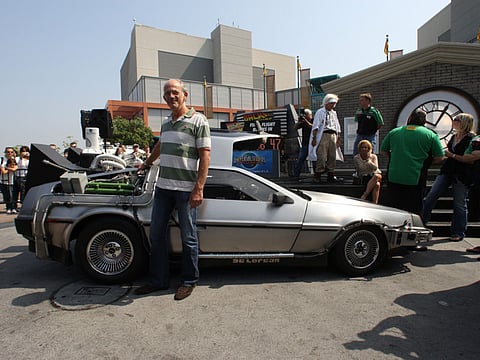‘Back to the Future’: A timeless time-travel movie
Michael J. Fox and the film’s stars reflect on the success of the franchise

Thirty years after the first film released, Michael J. Fox, 54, who starred as Marty McFly in the 1985 time-travelling adventure Back to the Future still has plenty of love for the film’s fans.
“You’re the most genuine people I’ve met,” he said at a convention in London to celebrate the 30th anniversary of the film’s release earlier this year. “If that’s what a nerd is, then that’s what Marty is too.”
Claudia Wells, who played Marty’s girlfriend, Jennifer, in the first film, revealed the first time she had been struck by the impact of the movie — was after she received a long handwritten letter from someone who had coped with a tricky childhood through repeated viewings of the movie. “He watched the film every night. We were his family. We were the reason he chose not to commit suicide.”
Back to the Future was released over the Independence Day holiday in 1985 and took $383 million (Dh1.4 billion) worldwide, making it the most successful film of the year. Executive produced by Steven Spielberg and directed by Robert Zemeckis, early versions of the script had the time machine as not a DeLorean but a Mustang, and even as a fridge — a concept rejected over fears children might get trapped inside them in an effort to recreate the film. The bolt of lightning required to generate the 1.21 gigawatts of electricity required to power the time machine was also, in one version, to have been generated by harnessing an atomic bomb.
“Probably not a great idea,” said Christopher Lloyd, 76, who played Doc Brown.
Attention among both fans and the studio, who are releasing a new DVD boxset, is now directed towards October 21 — the date to which Doc Brown and Marty McFly journey in the film’s second instalment.
As well as its healthy trade in replicas and tie-in T-shirts, the convention this year also raised funds for Up to 88, a campaign which aims to generate $88,000 by the end of the year for Fox’s charity backing research into Parkinson’s. The actor, who was diagnosed with the disease the year after the third film was released, said that when he was shooting the first film, he was not far off still being “a boy in Canada, thinking I was going to work in the fish docks. You didn’t want to wake up.”
His co-star Lea Thompson said the film gave her the best roles she had ever had, and the 1955 version of Lorraine — when she unwittingly falls for her son rather than his father — was the most challenging: “I had to get that weird, horny energy going all the time.”
The actor also lamented that despite now being 54, a couple of years older than Lorraine would have been in 1985, casting directors were reluctant to stretch her with roles as meaty as her alcoholic, cosmetically enhanced semi-sex-slave version in the second movie. “No one will give me that kind of part now. They think I’m nice.”
Fox credited the films’ enduring appeal to its central relationship — between the unassuming teenager and his eccentric mentor. “When you’re 17, a lot of things don’t seem possible. Doc shows Marty what is possible and he accepts him as he is, and invites him to share the adventure.”
The actor also paid tribute to Lloyd, saying he had never seen another actor as accomplished at making reams of exposition interesting: “He’s a genius.”
The pair fist-bumped, but Lloyd expressed more scepticism about the uniqueness of their characters’ bond. “[The Doc] would have found someone. Marty was just very receptive and awed.”
The movie’s legacy, said Fox, was also a product of its subject matter. “Ironically, for a time-travelling movie, there was a timelessness about it. Kids now like it. Though my kids haven’t watched it. Or, if they have, they haven’t told me.”
Sign up for the Daily Briefing
Get the latest news and updates straight to your inbox



